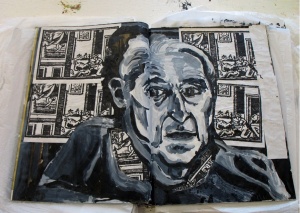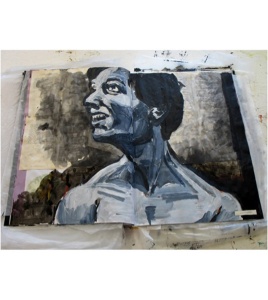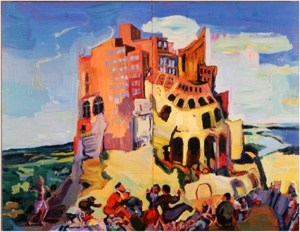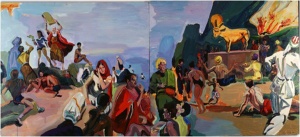Brighton Beach Bible
“We are in effect changing the rules as to what is aesthetically acceptable…. It is exciting precisely because we are changing the discourse [about Jewish visual expression and contemporary art].” Joel Silverstein made this startling proclamation in these pages three months ago in his exhibition essay Tzelem: Presence and Likeness in Jewish Art (May 6, 2009).
These radical ideas about the central role Jewish art is playing in contemporary culture are hardly new to Silverstein. He first concretely formulated them in an exhibition proposal for Yeshiva University Museum in 2006, stating that “It is our assertion that Jewish thought is a precursive factor in the formation of Modernism and postmodernism… [postulating] the relationship of artistic creativity to Jewish thought [and maintaining that] Jewish thought is demonstrated to predate and augment the advent of modern aesthetics.”
This belief in what he might call “the Jewish Sublime” flies in the face of most Jewish intellectuals idea that Jewish visual ideas are historically weak and fraught with fundamental problems and contradictions. Many believe that a singularly Jewish contemporary art does not exist at all. Nevertheless Silverstein persists in his beliefs; writing, curating and creating works of art that reflect a vibrant synthesis of his Brooklyn Jewish upbringing, Torah narratives and postmodern visual sensibility.
For the last decade Silverstein has been working on a series of artist books that provide an overview of his working methods, ideas and themes. The books are created on already published oversize anthologies, frequently anatomy books, which are then painted and collaged page by page with Silverstein’s own images.
The Black and White Book (2007) is in fact predominately in black and white and presents a diary-like confessional of the artist’s foundation motifs. His Brooklyn neighborhood friends, father, mother and wife predominate, as they become central characters in episodes of Jewish history. Ominously the Egyptian plagues appear again and again.

His father appears puzzled before a series of woodblock prints of plagues from the 17th century Amsterdam Haggadah. In the next image his mother smiles confidently in his painting of her high school graduation picture. The same plagues behind her are muted and less threatening. The artist’s friend

Pete is the most cheerful of all, almost delirious as his shadow momentarily obscures the text of a book on kabbalah. In Silverstein’s creations the past and its texts infuse his personal history and present.
Another artist’s book, Professional Criminals of 1888: Walking Wounded (2000-2009) explores contemporary history, Nixon, Brighton Beach bathers, Idolatry, Superman, and his own bar mitzvah and wedding.
The title page presents Pagan Art vs Jewish Art, proposing that pagan art leads to Hitler while Jewish art may lead to the risks of the Golem, an unholy emulation of god-like powers that are ultimately destructive. More images of the Golem, and the Jewish created Goyish echo, Superman, follow. The series quickly morphs into a nostalgic trip into Silverstein’s past; the Bar Mitzvah boy, his brother, his mother and father, fast forward to his wedding under the chuppah and then back to his Bar Mitzvah again. Suddenly an image of nine towering Babylonian idols plunge us into fears past and present. The series is a dizzying trip through a life steeped in normalcy and yet viewed through a hallucinogenic comic book lens.
Joel Silverstein’s paintings utilize a similar cast of characters and yet explore the Biblical narrative much more intensively. Tower of Babel (1998) is a classic example of Silverstein’s multiple visions. The composition is taken from Pieter Bruegel the Elder’s 1563 painting of the same subject, yet here the tower is partially transformed into an actual Brighton Beach apartment house. The foreground figures combine contemporary beach images with dancing people derived from the early works of the Spanish 18th century master Goya. The liveliness of color and movement animate the painting wonderfully, highlighting the timeless human folly of attempting to conquer heaven and dethrone God, now seen as a contemporary surreal farce.

Babel as a subject is an anomaly since many of his subsequent works focus on the Exodus and its preceding plagues. It is almost as if the experience of growing up is embodied in the Biblical exodus and seen predominately in terms of the terrible plagues that afflicted the Egyptians and yet were really meant to impress the Israelites. We began to mature as a people through the terrors of the plagues.
Early in the Morning (Exodus 24:4) (2006) connects perfectly as Silverstein integrates text with idiosyncratic images to make us reappraise the text. The first sacrificial experience of the Jewish people is of being sprinkled with the blood of the offering that accentuates their breathless fear. In the chaos of newfound freedom ferocious Egyptian horses and a tumbling soldier combine with a hesitant couple to suggest that return to Egypt might not be a bad idea. Just as we ultimately cannot know the sufferings of their slavery, we cannot understand the confusion of their freedom.

His earlier paintings; Golden Calf (1999) sets the tone with a dual images of Moses smashing the Tablets and a giant golden calf, both from the pop images from the 1956 epic “the Ten Commandments” starring Charlton Heston. The grandiose drama of this narrative is wrenched into contemporary reality with images of Silverstein’s wife, friends and parents. So too in Parting (1998) the conflation at the Red Sea becomes a heroic ode to a modern family’s liberation. The contemporarily foreground figures give a unique grand scale to the enormous acrylic on wood painting measuring 5’ x 12’.

The use of the Exodus narrative as a modern metaphor is fully explored in two recent large paintings set literally on the sands of Brighton Beach. A Plague of Beasts (2005) [4’ X 7’] presents an alarming vision of everyday beach-goers mingling placidly with lions and tigers. This is no peaceable kingdom, rather the locals are simply oblivious of the ferocious animals. The sense of impending danger that everyone is blind to becomes overwhelming as the distant Parachute Jump echoes ominously as a local 3 Mile Island disaster. Even the streimel-clad Hasid in the foreground doesn’t notice the tiger and lion at his feet. It would seem that the contemporary world is inherently incapable of seeing the plagues sent to warn us and shake us out of our apathy.
Brighton Beach Exodus Shemos (2008) notches up the narrative into a symbolic symphony. Superheroes vie with Brooklyn locals in a metaphoric struggle of good and evil as Silverstein utilizes photographs, paintings of children’s action figures and a naturalistic beach landscape to present a biographical summation of the Exodus. In his use of such diverse elements he drives home his conviction of being able to bridge the gap between Jewish history and the contemporary world, finding himself in a fully postmodern universe.
Joel Silverstein’s vision is no less than revolutionary. His simultaneous insistence on the relevance of autobiographical references, pop culture, Brooklyn Jewish environment and Torah narratives is singular in contemporary Jewish art. Silverstein’s appropriation of modernist expressionist form in combination with such a heady mixture of themes and sub-themes makes for a liberating if not daunting image making. What is most exciting is that his courage to push pictorial boundaries while keeping the dialogue resolutely Jewish by insisting on a Torah narrative structure opens myriad doors of possibilities for other Jewish artists. More than his curatorial skills and written polemics Silverstein’s image making is what points to a truly vibrant new Jewish art.